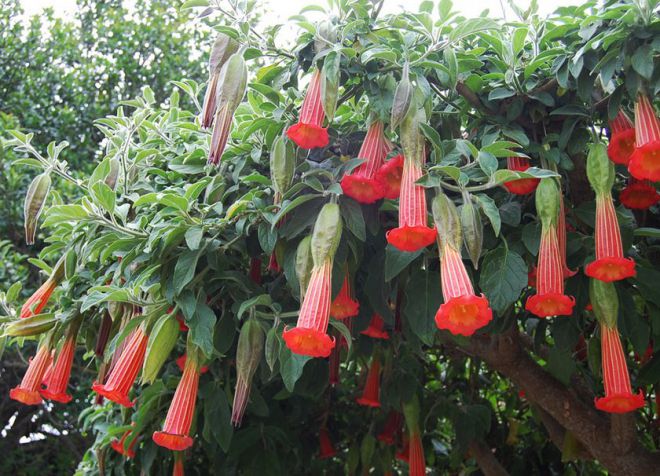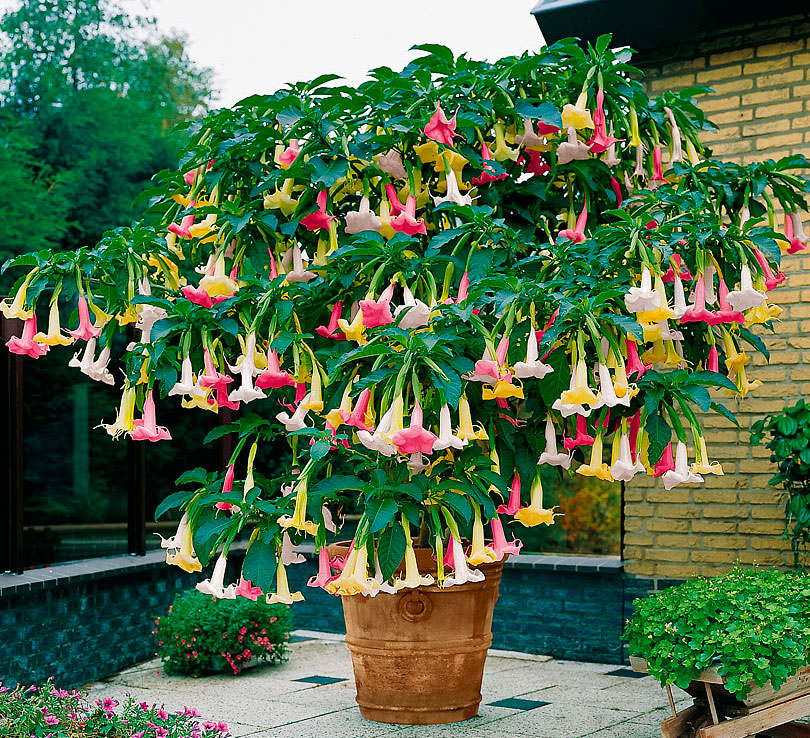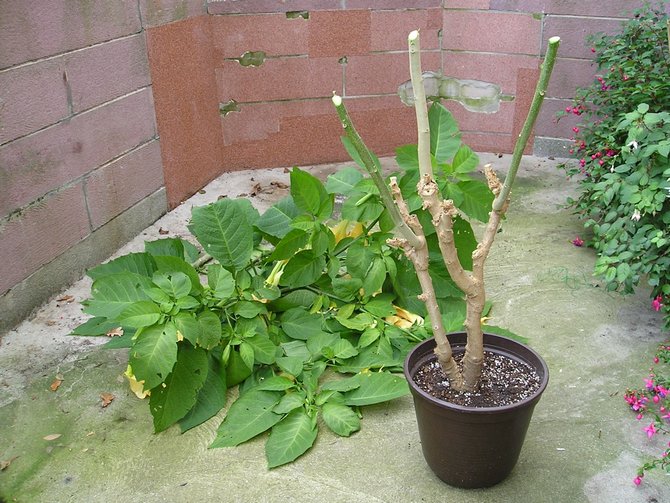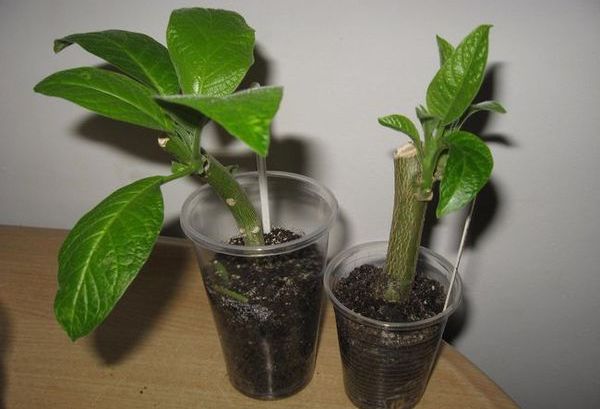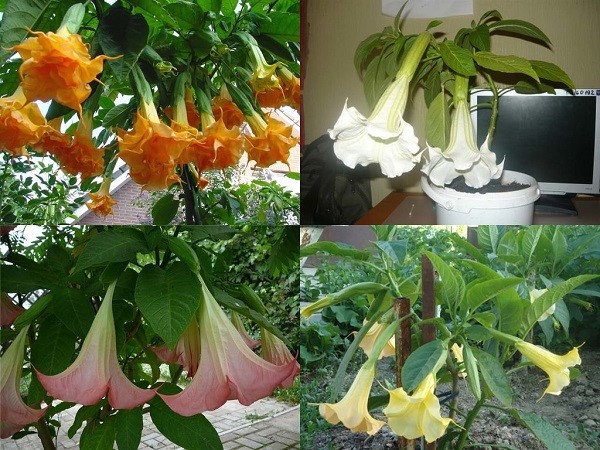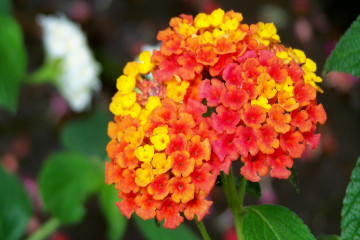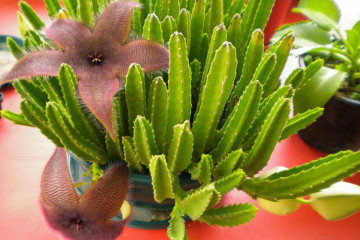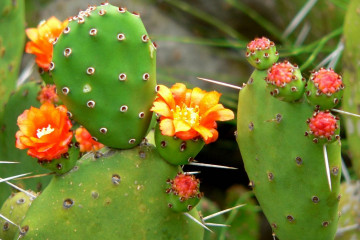Brugmansia flower: examples of care and methods of reproduction
Content:
Brugmansia, "trumpets of angels", the archangel flower is a common shrub, the flowers of which have a strong aroma. Several centuries earlier, flowers were used to make tinctures or bouquets that were intoxicating. Thanks to the work of breeders, in our time varieties have been bred that do not harm the body, and are an adornment of any personal plot.
History of appearance
In ancient times, this plant attracted shamans and magicians to prepare tinctures and potions, which, in their opinion, had magical properties. Initially, brugmansia belonged to the Datura family, these potions and tinctures had an effect on the human body. It is not known for certain which type of brugmansia was first discovered.
The homeland of the shrub is South America. For the first time, the brugmansia flower was mentioned by Branedba Kobo in the 50s of the 17th century. The description of tree brugmansy is mentioned by Louis Felluld in 1714. It received its current name at the beginning of the 18th century in honor of the history teacher Sebald Brugmans.
What brugmansia looks like
Brugmansiya is considered a miniature tree. Some species grow in bushes. This ornamental plant belongs to the Solanaceae family. Initially, due to the content of psychoactive substances in its chemical composition, it belonged to the genus Datura, or Datura.
The height of the ornamental bush is about 2 m, while in the wild, brugmansia can be several times higher. The plant develops quickly enough, but the process of woody shoots takes place very slowly. In order to have a beautiful bush or tree at home or on a plot, you need to regularly cut side shoots. The root system of the flower is powerful. The roots go very deep into the ground. The leaves of brugmansia are smooth at the edges, there is a light fluff in the middle. The plant stands out during flowering. The flowers are tubular, similar to drooping bells, are impressive in size. Their diameter is 15 cm, the length ranges from 20 to 25 cm.
Common varieties
The most common varieties of brugmansia are:
- Brugmansia suaveolens, or fragrant brugmansia, can bloom throughout the year under certain climatic conditions. This type of plant has Brazilian roots. Brugmansia pink in the wild reaches 5 m in height. The flowers are white or milky green.
- Brugmansia aurea, or golden, is so named because of its characteristic color.
- Brugmansia candida, or snow-white, gets its name from the white flowers. This species has been used by breeders to breed most of the ornamental varieties of Brugmansia. In the wild, the height of this species reaches 3 m, the decorative form of the shrub grows no higher than 2.3 m.
- Brugmansia sanguinea, or bloody, stands out with rich orange or even red flowers. This species is widespread on the territory of Russia, as it has good winter hardiness.
- Brugmansia versicolor - This variety is called multi-colored, because the flowers change their color according to the age of the shrub. The young bush blooms with milky flowers. The older the brugmansia becomes, the more the color of the flowers changes. The bush, which is more than 7-10 years old, has bright tangerine flowers.
- Brugmansia yellow is one of the most common species in Russia. Flowers have a yellow tint.
There is also a variety Brugmansia Aromagiya pink. It is distinguished by pink flowers that exude an aroma not only in the evening, like most varieties, but throughout the day. It is not recommended to keep it at home.
Home care
Brugmansia planting and caring for which requires certain knowledge and skills is a rather capricious plant. If you do not adhere to some rules, most plant varieties will not stand the climatic conditions of Russia. It is grown in winter gardens, greenhouses, houses and apartments.
In the open field in northern latitudes, the shrub is extremely rare.
Temperature
All plant varieties are very fond of warmth. At a temperature of -5 ° C, the flower is attacked first by diseases and pests, then immunity decreases, then it dies altogether. The most optimal temperature indicator for the development of tree brugmansia is 23 ° C.
Watering
This is a moisture-loving plant. Caring for brugmansia involves frequent watering. In winter, the amount of watering can be reduced to 2-3 per week. The amount of watering in winter depends on the air humidity. Drying of the soil is a dangerous factor.
Location
Brugmansia does not tolerate drafts at home for this reason, it is located in a well-lit, warm place, with the presence of supports for the branches. The plant goes into a state of sleep when there is little light.
The soil
Prefers fat, loamy soil.
In winter and spring
For the winter period of time, the cultivation and care of the brugmansia plant is transferred to indoor conditions. The flower pot is installed in a cool place. The greater the illumination of the room, the less likely it is that brugmansia is at rest. Some growers grow shrubs in winter, using phytolamps or additional artificial lighting. For the transition of brugmansia to the growth phase, it is necessary to provide it with a temperature of at least 15 ° C and the duration of daylight hours at 14-15 hours.
If the plant grows indoors, it is recommended to transplant it every spring into a container 2 cm larger than the previous one in diameter and height. Since the increased sap flow begins in the spring, it is necessary to apply universal nutritious fertilizing to the soil 1 time in 14 days. In the spring, the number of watering and spraying increases. Air humidity should be about 60%.
Pruning rules
Pruning brugmansia is necessary regularly. Young shoots growing between the trunk and leaves must be pruned. This will help to form a bush or tree at the same time and provoke it to bloom. As a rule, pruning is carried out in the middle of autumn, before the brugmansia is brought into the wintering room.
Reproduction methods
Brugmansia reproduces in 3 ways:
- Seeds;
- Cuttings;
- Layers.
Seeds
Brugmansia from seeds at home begins to grow in early January. Brugmansia can be planted until mid-March. The seeds are laid shallowly into the ground, approximately 0.5-1 cm. After they are covered with earth, it is recommended to moisten the latter well and make a kind of greenhouse, covering the area with planting with a film.
Cuttings
There are 2 types of cuttings of a shrub or tree:
- Stem;
- Root.
Cuttings are allowed to propagate brugmansia, which is at least a year old. This procedure can be carried out 2 times a year: at the beginning of autumn and at the beginning of spring. Most gardeners prefer to cut the plant in the spring, believing that the root system develops faster during this period. What is the time to plant brugmansia in the spring? You can start doing this from mid-March. This method is easier than the previous one. In addition, a shrub or tree propagated by cuttings develops faster, respectively, blooms faster.
For harvesting cuttings, you should choose stems, the length of which is not less than 25 cm. The stem is cut with a pruner, from its upper part, under the apical branching. As in most cases of plant propagation by cuttings, the lower leaves are completely removed from it, the upper ones are cut in half.
Root cuttings of brugmansia is a preferable method for beginners, since the shrub that has grown after applying this method takes root better, develops faster, and is easier to care for.
Rooting of cuttings is carried out either in water or in a special soil mixture.
Layers
This is the most time consuming way of breeding brugmansia. In order to obtain layering, it is necessary to select a well-developed shoot on an adult plant and make a shallow incision in the bud. Further, a root growth stimulator is poured into it, and the entire incision site is wrapped in moss. Moss is purchased special, for example, sphagnum. It is very important to keep the incision moist at all times. This procedure is carried out in mid-March, already in mid-June, the resulting cuttings can be cut off and planted in a nutrient substrate for 14-21 days. After the shoot has begun to grow, it can be transplanted to a permanent habitat.
Brugmansia flowers are not too capricious in content, but if you do not follow the basic rules for care, the shrub may die. By placing the plant in a warm and bright place, regularly fertilizing the soil with nutrients, maintaining a certain air humidity and making timely pruning, you can enjoy the long and lush flowering and exquisite aroma of this exotic flower.

